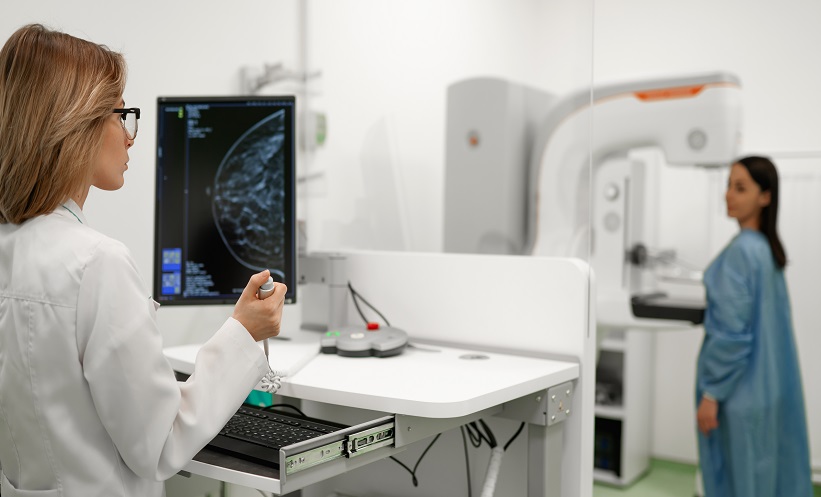Maureen Kohi | Ernest H. Wood Distinguished Professor and Chair, Department of Radiology, University of North Carolina (UNC) at Chapel Hill, USA.
Citation: EMJ Radiol. 2024;5[1]:44-46. https://doi.org/10.33590/emjradiol/10302707.
![]()
Having read about your extensive work in the field, what led you to focus on interventional radiology (IR) as opposed to other areas of healthcare?
During medical school, I found myself gravitating towards procedural specialties, such as surgery. What attracted me to IR was the innovative nature of the field. I was fascinated by how we could treat complex diseases through a minimally invasive approach, with fewer complications, quicker recovery, and at times, better results compared to surgery. I fell in love with the diversity of the procedures and the elegant techniques.
Our readers may find it interesting to hear that much of your work is centred around female health. What are your primary interests in that field, and what was it that made you want to work in that space specifically?
I have been fortunate to have a very broad practice in IR, taking care of patients with a variety of diseases. However, in the field of IR research, my focus has been on female health and interventions. I have learned a great deal by leading clinical trials comparing different minimally invasive therapies for uterine fibroids, uterine vascular anomalies, and morbidly adherent placenta, or evaluating the different sex-based outcomes of interventions for peripheral arterial disease. I also feel that there is still a need for robust data to support the role of minimally invasive therapies to promote female health. Let’s take uterine fibroids, for example. This is the most common benign disease of the premenopausal female pelvis, and yet the most common reason for hysterectomy in the USA is uterine fibroids. We take out an entire organ for a benign disease. Think of how rarely we do this for other processes; we do not take out somebody’s lung because they have a pulmonary arteriovenous malformation, we embolise it. You do not take out a kidney because somebody has angiomyolipoma, you embolise it. So, why is it that for a female, so long as they are done with childbearing, they are relegated to a hysterectomy? What if they don’t want to have their uterus removed?
It was that kind of advocacy for female health that got me started in female health research. It’s fascinating to run a clinical trial, and show that one therapy is superior to another for a disease state, and help to impact the lives of people who have commonly been neglected, which in most cases in medicine includes females, children, and underrepresented minorities.
Do you think that underrepresentation and the nonchalant approach to female health in general are the most significant areas that are still lacking in clinical care and radiology?
Absolutely! The COVID-19 pandemic opened up people’s eyes to health disparity. There were so many people that suffered and died from COVID, and so many people who didn’t. When you looked at it, you realised that if you’re affluent and have access to healthcare, you are likely to do better than someone who has a lot of comorbidities, hasn’t had proper preventative care, or doesn’t have access to healthcare. Many of us have known that disparities have existed in every field of medicine for years.
I think that one of the reasons we haven’t really dived deeply into this matter has been the quality of our clinical trials, preventing patients who are underrepresented, or don’t speak English, from being included in the trials. For example, diversity of patient population and backgrounds has long been lacking in the makeup of nearly all peripheral arterial disease clinical trials. This lack of diversity was not only restricted to the patients, but also included the clinical trial leadership and research coordinators, etc. If the trial leadership is not representative of our patient population and there is no emphasis on diverse patient recruitment strategies, then chances are that the trial will not recruit diverse patients. As a result, we will be left with trial results from a certain group of patients, i.e., White males or adult patients, which we will extrapolate to our female, underrepresented minorities, and paediatric patients. This is not the best way of practising medicine.
What is being done to increase diversity in radiology and clinical trials?
The main issue is that we don’t have diversity in the field of radiology as practitioners. Diagnostic radiology in America is composed of around 25% female specialists. So, one-quarter of radiologists in America are female, and in interventional radiology, it’s about 10%. That number may have increased a little bit.
What we are doing to address the lack of diversity, as it applies in the gender gap, at least, is to try to recruit more females into the field of interventional radiology. In the latest data I was looking at just recently, about 20% of the applicants to interventional radiology are female, which is fantastic! I hope we continue to see more females enter the field of interventional radiology.
We’re not seeing that much of an increase in diagnostic radiology, unfortunately, so we have some work to do. We need more females, and more underrepresented minorities, because patients want to see people who look like them. This also validates the trust in the clinical trial; if we have more females in the fields of radiology and interventional radiology, then we can teach them to become physician scientists, and then they can be the next generation of principal investigators running the clinical trials. They can go in with the mindset of recruiting a more diverse patient population into the clinical trial. The first step is outreach; we have to try to create pathway programmes to get medical students, college students, and high school students educated and excited about the field of interventional radiology.
What do you think are the most exciting new developments in radiology and female health taking place at the moment, and how will they impact clinical care in the future?
I’m super excited about a new prospective, randomised controlled trial (RCT) called Embolize, that hopefully will open in the next few months. Embolize is going to be a pivotal landmark clinical trial, because it’s prospective, randomised, sham controlled, and it addresses pelvic venous disease. This is a condition that has been neglected in females for years, and now, we’re doing an RCT, to try to show that embolisation is a safe and effective therapy for the management of this condition. We need this RCT to get insurance coverage for this procedure, because even though we have a lot of single arm clinical trials and case series, most insurance companies in the USA still consider embolisation for pelvic venous disease to be experimental.
I think in the world of radiology, what’s really exciting is artificial intelligence, and how we can leverage deep learning pathways to improve our efficiency and clinical excellence. I’m very excited about the future of artificial intelligence and its integration into diagnostic and interventional radiology. Ultimately, I feel it will help us take better care of our patients.
What is next for you and your research in interventional radiology at the University of North Carolina (UNC)?
I really love being a Department Chair and being an integral part of a distinguished school of medicine and healthcare system. However, regardless of how busy I may be in my administrative role, I will still want to be an interventional radiologist and take care of patients, and continue to contribute to the field with scholarly activities. I deeply believe in the tripartite mission of compassionate clinical care, research innovation, and educational excellence. It’s incredibly rewarding to take care of patients, to teach a resident or convince a medical student that interventional radiology is the best field, and run a clinical trial that will change the way medicine is practised in the future. I love each of these components and can’t imagine a future without them.








